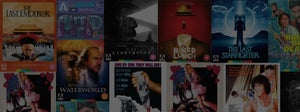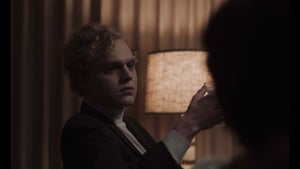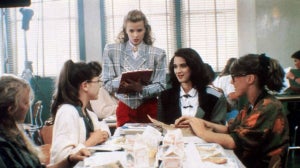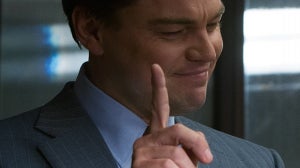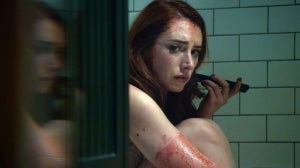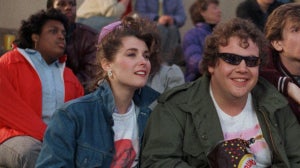
It becomes apparent that there is a continuity and DNA to Vincenzo Natali’s work ― from his early experience as a storyboard artist on Johnny Mnemonic, through to developing William Gibson’s Neuromancer… right up to the recent adaptation with Amazon Original’s The Peripheral. Ever since his debut sci-fi/horror Cube in 1997, as an independent filmmaker, Natali continued to deliver some of the most economically charged and thought-provoking works so far this century. He is, himself, the definition of cult cinema, not only through his (often) overlooked output (Cypher, Nothing, Splice), but his tastes, his sensibilities and approach to projects. There is an attention to detail ― read his scripts, pour over the concept art via his archive ― in which he embraces storytelling that resonates throughout everything he puts his heart and mind to: from abandoned projects (High Rise and the aforementioned seminal cyberpunk classic) to the films and television that eventually see the light of day.
There is warmth and passion for the creative process; that enthusiasm and infectious side we see in the best of them; his early memories (and influences) dating as far back as The Golden Voyage of Sinbad and Star Wars in 1977, before hooked on the more subversive worlds of Lynch and other auteurs. We caught up with Vincenzo as he gave us his top Arrow films in Vincenzo Natali Selects on ARROW.
Do you feel you grew up at the perfect time in cinema?
Oh, yeah. I really thought that period from the late ’70s through the ’80s was a magnificent time to grow up and to be alive. Movies are a big chunk of my brain. I can attribute a lot of my neural networking to the cinema that I experienced growing up… but less so now. As an adolescent, during the early eighties, I discovered Eraserhead, Das Boot and Diva, the latter films opening me up to foreign cinema. Somehow these cinematic worlds seemed to echo what was going on in my brain and as my mind evolved and developed, so did the movies. There was now this huge catalogue of older films; all the Bergman, Fellini, and Kurosawa that I would discover in theatres during my early teens; such a vibrant time… and it was just as VHS was emerging. It seemed that cinema back then was all about experiencing movies in the theatre, which to this day is the only way I can fully enjoy a film. Now we’re into something entirely different. It doesn’t stand on a pedestal now the way it used to when I was growing up. It feels like it kind of sits or stands side by side with a bunch of other mediums… it’s more dispersed. Back then, it was like like going to church. A very meaningful experience; the act of going to a movie theatre and sharing something with an audience on a continental or global level, which I don’t think really exists anymore. So I feel lucky. I feel very fortunate.
Film memories and appreciation should be cherished; it all forges crucial moments in shaping individuals and, as a filmmaker, your art.
It’s a much different media landscape now. The test of a great movie ― a truly great film ― is when, after leaving the theatre, there’s a kind of ‘persistence of vision’; where the film was so evocative, so powerful that I walked away seeing my world through the filmmaker’s lens, through their perspective… even after it was all over. I’ve had that happen a number of times, like when I was a kid walking out of Eraserhead or Blade Runner ― that I was still in those worlds ― and, in particular with David Lynch’s films, I wasn’t just watching them, I was in them. It’s like someone is articulating something that was already inside me before I even saw the film. That’s a magnificent moment for anyone when they find an artist who can do that… and who you connect with in that way.
Do you think there is something very specific about Canadian cinema ― whether we are talking about Canuxploitation or not ― and, as an American-Canadian, do you share inherent tracings of one or the other?
I don’t think that Canadian cinema ― outside of David Cronenberg’s work ― directly influenced me growing up. It was there but it was kind of in disguise like you wouldn’t even know because the films that were made in English-speaking Canada ― such as that period during the ’70s with the tax shelter films ― were designed to be as commercial as possible so they could be sold to American studios as ‘American movies’. Therefore, it was rare that you would see a ‘Canadian film’ where anyone would reference anything Canadian. So you didn’t notice. Now, having said that, when you look at a lot of Canadian cinema, I think it’s more akin to what comes out of Scandinavian cinema than it is to American, in that it tends to be very internal.
What do you feel defines those crucial differences between American and Canadian filmmakers?
I think this comes down to how much more trustful we are of our political institutions. We’re just not cowboys in the way that Americans are. We like to be policed and all of this influences the films we make as they become much more about the individual and what’s going on inside. In America it’s always about somebody fighting something on the ‘outside’, whereas Canada tends to be much more inward-looking, which I’m sure has everything to do with the climate that we exist in. Look at it like this: Canada is made up of all the people who didn’t want to fight the American Revolution. We’re the Brits that fought the Americans or the Americans that left America to fight with the British against America. I’m speaking for English Canada, of course. French Canada is almost like another country.
There is something more subtle about the internalised aspect that immediately makes such films more thoughtful. If somebody didn’t tell you it was Canadian, those undercurrents are there; that it feels inherently cold… somewhat ‘detached’.
And there’s just something about when you shoot scenes in winter that emphasises that all the more. I always feel like the enemy lurks within; as I say, that internal battle battleground as opposed to making a movie where it is a foreign enemy or entity.
https://www.youtube.com/watch?v=TFqL92bgNE8&t=19s&pp=ygUUZW50ZXIgdGhlIHZvaWQgYXJyb3c%3D
You state that your selection of ARROW releases happens to be all “characters pulled in an inexorable spiral toward madness and/or destruction”. Intentional or not, there are plenty of examples in your own work that explores this, whether confined or playing god. What attracts you to such themes?
I literally just went through the list, picking the ones that jumped out at me without thinking thematically or how they’re connected. Then I realised every single film was about people going insane or destroying themselves.
Whether by osmosis or arriving at such themes through the development of the material you are attracted to, ultimately, it all comes from somebody who understands what is needed to tell a story.
It is done with great intention. It’s always about what excites you… but God knows I don’t want to know why that excites me or why I connect with it so much. But it’s true… that’s why I’m attracted to horror in general. I always have been. It’s invariably horror that is always the metaphor for something, and, as mentioned, it’s usually a metaphor for something that’s going on inside. I guess that just touches a nerve. I must admit, I don’t want to know why I’m attracted to it, but I have consistently found when I meet horror filmmakers, they’re the sweetest people on Earth. As Joe Hill said to me once, “If you’re drawn to horror, it’s not because you’re a sadist, it’s because you’re hyper-empathetic.” Yes, you are. It’s dark… but if you are sensitive to the horrors of the world then this genre is a way of dealing with all of that. It’s about coming to terms with the real monsters and horror out there.
Your list highlights your love of Japanese cinema. Have you always been attracted to their stories and approach to filmmaking?
I was brought to Japan when Cube was released and I just felt immediately at home there. It was exotic to me on a certain level, but on another level I just felt very comfortable there, more comfortable than I do here in North America. It’s a beautiful culture that produces amazing art. The food is incredible, the people are incredible, and the cinema is incredible. There’s also something about the extremity to which the Japanese approach… well, anything really. I can see somebody cleaning the street and they’re doing it with such attention and intent, and when it comes to their art, it’s the same thing. Their cinema, indeed, their entire culture, is highly concerned with (and aware of) aesthetics. It can be formal and beautiful… and I appreciate formal cinema.
https://www.youtube.com/watch?v=UBnQnWK3XFA&pp=ygURYmxpbmQgYmVhc3QgYXJyb3c%3D
The mix of ancient beliefs and the obsession with technology ― how these things have merged ― are particularly fascinating and become the ‘ghosts in the machines’ that have defined their science fiction and horror.
When it comes to their science fiction, maybe it’s because of Shintoism; their belief that everything has life. Even objects have life; there isn’t this fear of technology because it’s accepted as something natural. It feels alive… other, so there is a much more holistic view of technology and how it connects to us that includes the value of machines. If you look at all the carousels of films with ‘cursed tech’, they’re just so timeless.
Through their cinema and culture, we realise Japanese morality is different too… less judgmental. I don’t know if it’s because the West is influenced so heavily by the Church, but our storytelling tends to be very judgmental. Whereas I think in Eastern cinema (and certainly in Japanese cinema), there doesn’t seem to be a clear moral statement. If you measure this against commercial films where it is often beating you over the head with a message, in Japan there is always a sense of moral ambiguity and pushing things towards some other inexplicable place. That’s more intriguing and refreshing to me.
How important do you feel the reappraisal, restoration and curation of cult and classic movies is today?
I think it’s a wonderful time for all of that… and not just cinema; I’ve noticed it also in comic books. With these digital avenues that are available to us, a lot of material that wasn’t available is now, suddenly, “coming to an iPad near you”… and a lot of it is restored and presented in pristine condition. So a company like ARROW I really appreciate, taking what was once very obscure material and giving it the Cadillac treatment in their transfers and the materials that accompany the release.
Whether you are in the industry, a cinephile, discovering a newfound interest in film or expanding on (and challenging) your tastes… you should feel educated.
It’s magical. I always felt like I knew just about everything that came out after 1977 (or at least would have heard of), but there is now a wealth of unearthed celluloid.
It would have been sacrilege not to have Tideland on your list. With Terry Gilliam being such an influence on your own work, what did you take away from your 2005 documentary Getting Gilliam?
While with Terry Gilliam I learned more about a mentality towards filmmaking and being on set rather than anything technical. I grew up with Monty Python, and so, without even knowing who he was, I knew loved his animation from a very early age. And then later on, Holy Grail and Time Bandits were very important to me growing up. When I eventually discovered Brazil it fried my brain. I never touched drugs ― I didn’t need to because of movies like Brazil ― it was just such a mind-melting experience. I truly feel he’s one of the great filmmakers of the 20th and early 21st century, so when I was working on High Rise and producer Jeremy Thomas asked: “You want to come and make a documentary?” I jumped at the chance.
I really just tried to focus on Gilliam as a director who is an endlessly entertaining and very willing subject. What I appreciated the most from him, as a younger filmmaker, was his enthusiasm, his giddy playfulness while he was shooting. He was a great audience for his performers while he was directing and I think up until that point, I’ve always held back a little bit and then I realised that doesn’t help anybody; that there’s kind of an effectiveness of communication that is really healthy for the art of the production. There are a few of these sort of magical unicorn-type characters out there, and he’s definitely one of them. I hope that comes across in the documentary.
Personalities and auteurs. Whether Guillermo del Toro or Terry Gilliam, they’re enthusiasts, first and foremost, who have an unrivalled passion for creativity. They know what to grab off the shelf and use to communicate to three or three thousand people on set in an instant.
Yeah, which feeds into why I one hundred percent subscribe to ‘auteur theory’. And that doesn’t negate anything about the contributions of everyone else involved. A film becomes an organism and the director is the brain of the organism. Such filmmakers are very pure… and to a fault. They suffer for their purity. Someone like del Toro is a very pure soul and (at least I don’t think) is capable of doing anything that isn’t right for him. But that’s why people connect with his movies. One of the reasons I put Tideland on my list was not just to champion, but because I love its purity. There is also this meta take on Alice in Wonderland; that perfect double bill with del Toro’s Pan’s Labyrinth, the latter the more charming of the two. Tideland ― the more I think about it ― is the more dangerous of the two movies; Gilliam goes outside a comfort zone towards something more transgressive. That’s why people didn’t like it, but it’s worth the watch. I think it’s a beautifully made movie; a fascinating and provocative exploration of the turbulence that comes with childhood; the myth and innocence and the deconstruction of those things.
https://www.youtube.com/watch?v=cUo2krFb8wk&t=53s&pp=ygUUYXVkaXRpb24gYXJyb3cgdmlkZW8%3D
If you were to choose one film as an entry point to your list, which would it be?
I think an ‘audience friendly’ film ― even though it’s a harrowing experience for anyone who sees it ― is Takashi Miike’s Audition. I think it’s a movie that is inherent and I’ve never heard anyone say a bad thing about it. It’s a good entry point because it’s a guaranteed win. Some of the other films on my list, such as Fear of Fear, might be a little hard to penetrate for some people. Audition will hook someone in… almost literally. I love that period of Miike’s work. I think he’s also one of those magical figures in film.
His work is incredibly dark and difficult to watch, but there’s always a ‘thing’ that he latches onto, from the thematic to the texture of filmmaking; video footage, animation…
Yeah… and I feel there’s just so much freedom and energy in what he creates. I have to assume this is partly because he was making five films a year. He was never afraid of failing and so his films work because he’s very courageous; he’s gone places that many other filmmakers would never dare to. I put his version of Graveyard of Honor on my list as well, which to me is like his Raging Bull, in that it’s devastating. There are no apologies made for this character, he is just there. A monster. And it’s just brutal; a perfect example of him making no attempt to show someone palatable or sympathetic whatsoever… and it’s all the more thrilling for that reason alone.
See Vincenzo's full list of picks in Vincenzo Natali Selects on ARROW. Getting Gilliam is available on the Tideland Blu-ray.

Related Articles
